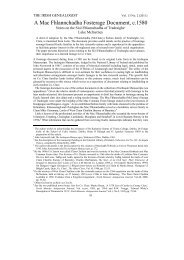Report Cover Vol I - Clare County Library
Report Cover Vol I - Clare County Library
Report Cover Vol I - Clare County Library
Create successful ePaper yourself
Turn your PDF publications into a flip-book with our unique Google optimized e-Paper software.
The <strong>County</strong> <strong>Clare</strong> Wetlands Survey Patrick Crushell & Peter Foss 2008<br />
_______________________________________________________________<br />
Appendix 6b: Freshwater habitat types descriptions<br />
Reproduced from a Guide to Habitats published by the Heritage Council (Fossitt 2000). Copyright The<br />
Heritage Council.<br />
In the case of each wetland type the relevant level 1, 2 and 3 Fossitt habitat type code and descriptive<br />
information for the wetland habitats is presented.<br />
C Coastland<br />
This section includes habitats of the coast that are either above the level of high tides but have a strong<br />
marine influence, or those in the littoral (intertidal) zone that are dominated by terrestrial vascular plant<br />
communities. Vegetated strandlines are an exception as they are considered as part of the seashore<br />
under littoral sediment in the marine littoral section. Brackish water systems are included here.<br />
CW Brackish Waters<br />
CW1 Lagoons and saline lakes<br />
This category includes all enclosed bodies of standing brackish water that are wholly or partially<br />
separated from the sea by banks of sand, shingle or rock, or by land barriers of rock or peat. Tidal<br />
influence is much reduced by these physical barriers or is totally absent. Water levels in lagoons<br />
generally undergo seasonal fluctuations (high in winter and low in summer) unless strictly controlled by<br />
pumping. Strong water currents are absent and this is a key feature which distinguishes lagoons from<br />
other marine water bodies. Salinity is highly variable both within and between different lagoonal systems.<br />
It fluctuates on a daily and seasonal basis, depending on tides and inputs of freshwater and, in some<br />
situations, may exhibit the full range from sea water to freshwater conditions. In addition to typical<br />
sedimentary lagoons, this category also includes brackish waters that have become impounded behind<br />
artificial barriers (usually as a result of construction), coastal lakes with natural outlets to the sea that<br />
experience some tidal exchange at high tide or during storm conditions, and other lakes that are isolated<br />
from the sea but which are slightly saline as a result of percolation of sea water or inputs from salt spray<br />
and storm waves or surges. The latter are mainly associated with fixed dunes - CD3 and machair -<br />
CD6.<br />
For a body of water to be classified as a lagoon or saline lake, there should be detectable salinity in the<br />
water (>1%o) and, if there are fluctuations in water levels associated with tides, these are always much<br />
less than in nearby marine areas. Communities of submerged aquatic plants are characteristic.<br />
Tasselweeds (Ruppia spp.) are usually present and occur together with marine algae at high salinities,<br />
and with Fennel Pondweed (Potamogeton pectinatus), Brackish Water-crowfoot (Ranunculus baudotii)<br />
and Spiked Water-milfoil (Myriophyllum spicatum) at low salinities. Green algae (Enteromorpha spp.,<br />
Cladophora spp., Chaetomorpha linum) are common. Horned Wrack (Fucus ceranoides), and dense beds<br />
of eelgrasses (Zostera spp.) and stoneworts (including the lagoonal specialists, Chara canescens and<br />
Lamprothamnion papulosum) may also be present. A faunal community of brackish water species, some<br />
of which are lagoonal specialists, is joined or replaced by marine species at high salinity, and by insects,<br />
especially beetles and water bugs, at low salinity. Fringing salt marshes (most likely upper salt marsh -<br />
CM2) and reed and large sedge swamps - FS1 may be present and should be recorded as separate<br />
habitats.<br />
Links with Annex I: Corresponds to the priority habitat, '*coastal lagoons (1150)'.<br />
CD Sand Dune Systems<br />
CD5 Dune slacks<br />
Dune slacks are nutrient-enriched wet areas that occur in hollows or depressions either behind or<br />
between dune ridges, or in blow-outs in the sand dunes. The water table is either at, or close to the<br />
surface for much of the year and dune slacks may or may not dry out in summer. Vegetation typically<br />
comprises Creeping Willow (Salix repens), Creeping Bent (Agrostis stolonifera), Common Reed<br />
103
















